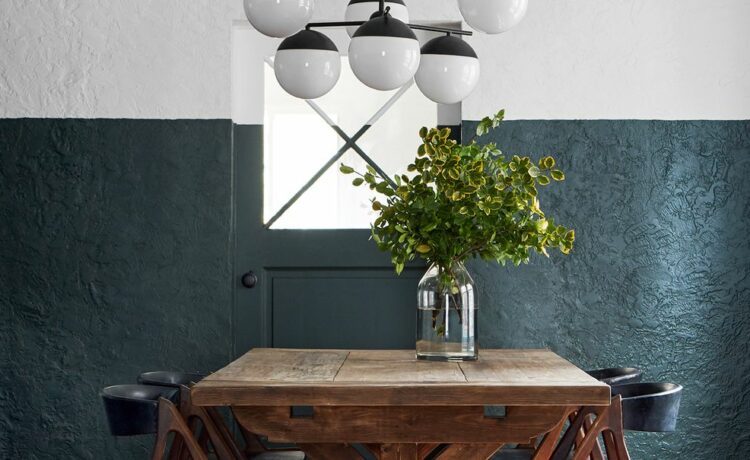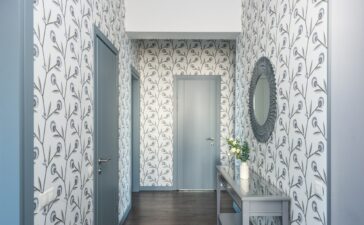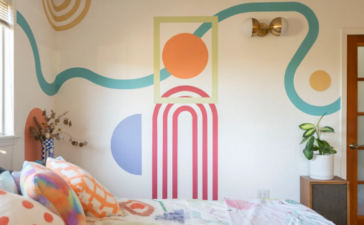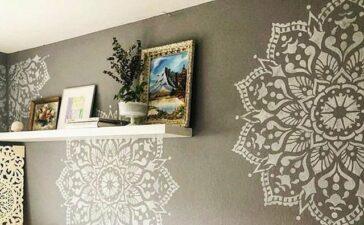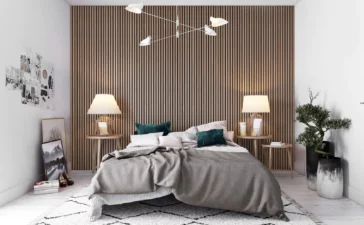Introducing an accent wall into your interior design arsenal introduces an ingenious way to breathe life and character into any room. The strategic selection of a singular wall as your canvas for creativity can elevate your space’s ambiance and add visual interest. By daringly incorporating a splash of vibrant color, a texturally rich surface, or an eye-catching pattern, you make a design that converges harmoniously to form a captivating focal point.
It takes you on a journey from the art of pinpointing the perfect location for your accent wall, considering factors like architectural features and room dynamics, to unveiling the finest nuances of style and design principles.
As you immerse yourself in this wealth of knowledge, you’ll uncover the transformative potential that accent wallspossess
Choosing the Ideal Wall for Your Accent

1. Opt for Walls without Windows
When choosing which wall to turn into a cement wall, it’s often best to select one without windows. This allows the accent color or design to stand out without competing with natural light sources. Consider walls opposite or adjacent to windows for the best visual impact.
2. Starting and Ending on Inside Corners
To create a seamless and visually pleasing transition between the accent wall and the surrounding walls, starting and ending the accent wall in an inside corner is recommended. This helps maintain a sense of continuity and prevents abrupt wending or disjointed appearances.
3. Accent Wall Placement and Colour Coordination
While accent walls can be a fantastic design element, it’s important not to go overboard. Limit yourself to one accent wall per area or room to maintain balance and avoid overwhelming the space. Additionally, consider the overall color palette of your entire home to ensure the accent wall harmonizes with the rest of the decor.
4. Drawing Inspiration from Interesting Features
An effective way to choose the color for your accent wall is to pull it from an exciting feature already in the room. It could be a piece of artwork, a vibrant rug, or even the color of your furniture. This technique helps tie the room together and create a cohesive design scheme.
Tips for Styling Accent Walls
1. Thinking Beyond Solid Colours

Regarding accent walls, solid colors offer a classic, timeless look that complements various design styles. However, if you’re eager to make a bold statement and take your accent wall to the next level, don’t hesitate to explore creative techniques. Color blocking with contrasting hues adds depth and visual interest, while ombre effects create a beautiful gradient for a sense of movement. Geometric patterns, like chevrons or hexagons, lend a modern touch to sophistication.
Consider using artistic wall decals or murals to transform your accent wall into a captivating masterpiece that can be easily changed. Texture, achieved through materials like reclaimed wood or brick veneer, brings warmth and a tactile appeal. Mixing materials, such as wood and metal or natural stone, with colorful tiles add an eclectic and artistic touch.
Embrace these innovative approaches, and let your accent wall reflect your style, becoming the focal point that leaves a lasting impression on anyone who enters the room.
2. Embracing the Beauty of Texture

The texture is an often overlooked aspect of accent walls, but it plays a crucial role in creating visually stunning focal points. Using materials like reclaimed wood stone veneer, or textured wallpaper, you can add depth and tactile appeal to your accent wall, elevating the overall design aesthetic.
The natural charm of these materials brings warmth and character to the room, making the accent wall an attractive centerpiece. Remember to underestimate the power of texture – it can transform a simple background into a unique and personalized masterpiece that leaves a lasting impression on anyone who enters the space.
3. Adding Accent Walls to Neutral Rooms

Neutral rooms, while often serene, can sometimes lack visual interest. To inject new life into these spaces, consider adding an accent wall. By carefully choosing a color or design that complements the neutral tones in the room, you can create a harmonious balance.
The accent wall should provide excitement and personality, becoming the focal point that brings depth and visual intrigue to the space. Whether it’s a subtle shade variation, a textured finish, or a patterned wallpaper, the accent wall adds a touch of vibrance and character, transforming the neutral room into a captivating and inviting environment.
4. Embracing the Power of Bold Colors

While neutral tones can be a safe choice, feel free to go bold with your accent wall. Vibrant colors like deep blue, rich red, or energetic yellows can add energy and personality to your space. Remember to balance the boldness with the room’s overall color scheme harmonizing with other wall colors.
Considering the surrounding walls’ colors is crucial when designing an accent wall. Ensure that the accent wall color complements and enhances the overall color palette. Harmonious color coordination will create a visually appealing and cohesive space.
5. Extending Accents Beyond Walls

Regarding accent walls, thinking beyond vertical surfaces can bring unexpected charm and interest to your space. Don’t limit yourself to traditional notions; consider extending the concept to other areas, such as ceilings, fireplace facades, or the back of built-in shelves. By incorporating accent elements in these unconventional spaces, you can create a unique and visually appealing focal point that adds depth and personality to your room.
Whether it’s a bold color on the ceiling, a decorative pattern on the fireplace, or a contrasting hue on the back of shelves, exploring these unconventional accent wall ideas can elevate your space and create a truly memorable design statement.
6. Exploring the Charm of Wallpaper

Wallpaper is a versatile and effective way to introduce pattern and texture to your accent wall. With an extensive array of designs and styles available, you can find a wallpaper that aligns with your taste and complements the room’s overall decor.
Whether you opt for a subtle pattern that adds a touch of elegance or a bold print that makes a statement, wallpaper can transform your accent wall into a visually captivating focal point. It adds depth, visual interest, and a unique character to the space, enhancing the overall ambiance and creating a lasting impression.
Essential Rules for Designing Accent Wall

Now that we have delved into various tips for styling accent walls, it’s important to understand the essential design rules.
These rules will help ensure your accent wall is thoughtfully designed and harmoniously integrated into your space:
1. Balance
A sense of balance within the room is crucial when designing an accent wall. This involves considering the color and visual weight of the accent wall about the other elements in the space. If the accent color is bold and vibrant, it should be balanced by neutral or subdued colors on the surrounding walls and decor.
On the other hand, if the accent wall has intricate patterns or texture, the other walls and furnishings should have simpler designs to maintain visual equilibrium. Striking the right balance ensures the accent wall stands out while harmonizing with the room’s overall aesthetic.
2. Proportion
When designing an accent wall, it’s crucial to consider the size and scale of the room’s wall. In larger rooms with ample wall space, you have more freedom to experiment with bolder and more intricate designs. These designs can create a captivating focal point that fills the space without overwhelming it. You can play with larger patterns, vibrant colors, or textured materials to make a bold statement.
However, a more subtle approach is advisable in smaller rooms to prevent the accent wall from dominating the entire area. A smaller accent wall may benefit from a more restrained design or a lighter color palette that creates a sense of openness.
Additionally, the accent wall’s proportion should complement the room’s dimensions and furniture layout. Consider the placement of doors, windows, and other architectural elements to ensure the accent wall fits harmoniously within the space. By carefully considering the size, scale, and proportion, you can create an accent wall that enhances the room’s overall aesthetic, regardless of its size.
3. Coordination
When selecting the color or design for your accent wall, it’s essential to consider the existing elements in the room and ensure that the accent wall complements rather than clashes with them. Whether your decor style is modern, traditional, bohemian, or minimalist, the accent wall should harmonize with the overall theme. When choosing, consider the room’s color scheme, furniture style, and decorative accents. If the room features a neutral color palette, you can opt for an accent color that complements and adds depth to the existing ones.
In a vibrant and eclectic space, you can choose a patterned or textured design that complements the room’s energy. The goal is to create a cohesive, well-designed space where the accent wall feels intentional and seamlessly integrated. Considering the room’s theme and existing elements, you can ensure that the accent wall enhances the overall aesthetic, contributing to an inviting and visually pleasing space.
4. Lighting
Lighting plays a crucial role in how an accent wall is perceived. Consider how natural light, as well as artificial lighting fixtures, interact with the accent wall. For example, a brightly lit room can showcase a bold accent color more prominently, while dimmer lighting may require a more subdued hue to maintain a balanced atmosphere.
Experiment with different lighting conditions in the room to see how the accent wall appears at various times of the day. Properly illuminated, the accent wall can create the desired ambiance, drawing attention to its features and contributing to the overall mood of the space.
Be careful considering these aspects- balance, proportion, coordination, and lighting- you can ensure that your accent wall becomes a visually stunning focal point that complements and enhance the entire room’s design. A well-designed accent wall not only adds character but also elevates the overall aesthetic of your living space, making it a true reflection of your style and personality.
Conclusion
Crafting an accent wall entails a harmonious blend of crucial elements that redefine your space. Begin by selecting the ideal fence, seamlessly integrating it within your room’s layout and architectural context. Infuse life through color or texture; a well-chosen shade can evoke emotions, while texture adds depth and sensory appeal.
Accent walls transcend convention, offering a canvas for limitless creativity. Embrace the interplay of colors, textures, and design as your space reflects your personality.
This symphony of elements empowers you to narrate your story through design, transforming your environment into an evocative masterpiece.
Frequently Asked Questions
Can I Have Multiple Accent Walls in a Room?
While having multiple accent walls in a larger space is possible, a limited area or room is generally recommended. Too is generally recommended many accent walls can create a cluttered and overwhelming effect.
Should the Accent Wall Color Match My Furniture?
The accent wall color doesn’t necessarily need to match your furniture exactly. However, it should harmonize with the room’s overall color palette and complement the furniture’s tones and style.
Can I Create an Accent Wall with Removable Options?
Various removable options are available for creating accent walls, such as peel-and-stick wallpaper or temporary paint. These options provide flexibility for those who want to experiment with different designs or change their accent wall in the future.
How Can I Make a Small Room Appear More Significant with An Accent Wall?
Choose lighter colors or subtle patterns to make a small room appear more significant with an accent wall. Avoid overly dark or busy designs, as they can make the room feel more confines.
Are Accent Walls Only Suitable for Living Rooms and Bedrooms?
Accent walls can be incorporated into any room, including living rooms, bedrooms, kitchens, dining rooms, and bathrooms. The key is to choose the right wall and design that complements the specific room’s function and style.





